Solar Educational Kits for Kids: Introduce Solar Energy to the Young Ones
April 4, 2022
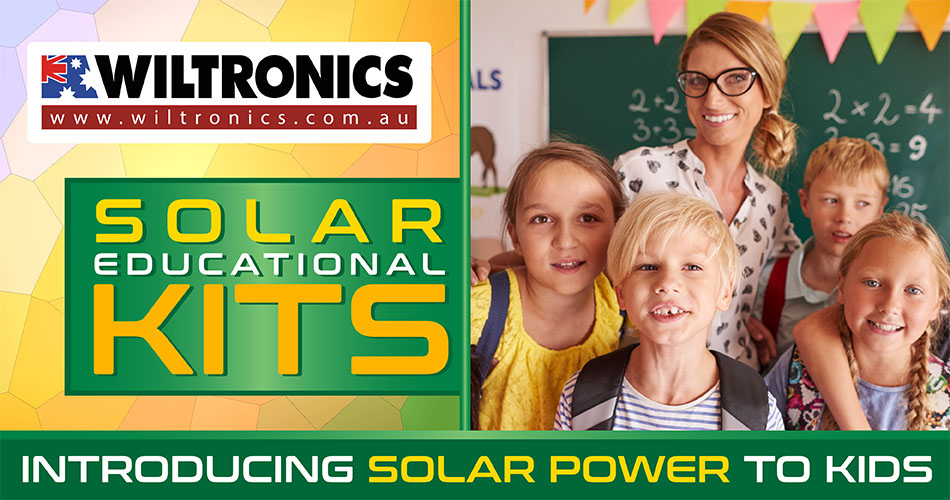
These solar educational kits are a brilliant way to introduce solar energy to the young ones!
Solar energy, coupled with solar panels, should be a fun part of education for kids. After all, in many cases, this is what powers their humble homes.
Many countries are looking for various ways to harness the power of this approach. In the future, this could lead us to a cleaner and pollution-free environment.
Thus, it is becoming more important to teach the young generation about solar energy. Information about the creation and use is vital — this is where solar education kits come in!
Ideal for academic purposes, they make the learning process both rewarding and exciting. Here is a kid-friendly introduction to solar energy and why children should know about it. Plus, the best finds on the market!
The Sun and Solar Energy
Solar energy begins with the Sun. It is where the primary source of all energy on Earth comes from.
The Sun lies at the centre of our planetary system. It is a cosmic energy source, a massive nuclear fission reactor, some 4.6B years old.
From its surface, light and heat travel into outer space and to Earth. And here, sunlight is by far the largest source of energy received by our planet.
Any type of energy generated by the sun is called solar energy. A renewable energy source that has positive, indirect effects on the environment.
Solar energy is capable of producing heat, causing chemical reactions, or generating electricity. A great example of this is the ‘melting ice’ experiment.
Place the cubes outside (e.g. backyard) on a sunny, but not too hot, day. Place one cube directly in the sun and another one in full shade. Have your child guess which will melt faster. As the one in the sun turns into a puddle more rapidly, explain that solar energy is the cause.
There are three primary technologies by which solar energy is harnessed. One of them is solar panels. Solar panels are a component of a photovoltaic system. Simply, they convert sunlight into electricity.
Renewable energy
When we use solar power, we do not use any of our planet’s resources like coal or oil. Solar power is also clean and does not generate a lot of pollution. This makes solar energy a renewable energy source.
Solar Energy and the Environment
Solar energy is a viable alternative to generating electricity from burning fossil fuels. Gas and coal, for one, contribute greenhouse gas (GHG) pollution into the air, water, and land. This directly affects the environment.
Further, the GHG created during burning fossil fuels can lead to:
- Damaged areas
- Acid rain
- Affected agricultural production
Using solar energy, paired with solar panels, can lead us to a cleaner future. As they emit pollution-free electricity, we are able to breathe purer air.
Solar Power for Electricity
Sunlight plays a big role in solar power production. This is where solar panels take advantage of it.
Solar panels are formed from a series of photovoltaic cells arranged into a panel. The light from the sun is composed of energy particles called photons.
As these photons hit the solar cell, they knock electrons loose from their atoms. When electrons zip through the circuit, the movement produces an electric current. These currents are then converted by the solar panels into electricity.
Solar Energy and the Younger Generation
Why should the younger generation know about solar energy?
The scope of solar energy is increasing day by day. Today (and in due course), many countries are looking for various ways to harness this approach.
Thus, it is becoming more important for us to teach them about it at the earliest opportunity. Provide available information on solar energy so they will become aware of the renewable energy options.
This would help kids as future consumers to make informed energy choices. Resources like wind energy with wind turbines are also useful to learn about. This way, reliable energy choices are appreciated by future generations.
Solar Energy Introduction Through Solar Educational Kits
DIY solar energy projects can also improve kids’ understanding of solar energy. A great example of this is solar educational kits.
This includes making solar robots, cars, boats, to name a few. Learning Science, in general, is a lot easier and more fun with the help of these solar toys!
Have a look at these simple projects/solar kits to introduce solar energy to children.
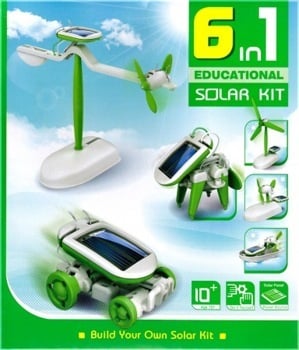
1. 6 in 1 Solar Model Kit
Product code: KI2026
Ideal for ages ten and above, learn how to drive a small motor with this 6-in-1 kit. The models consist of snap-together parts.
Children can build it without tools required. Thus making it great for first-time experimenters. Build six different working models: windmill, revolving plane, airboat, plane, car and puppy.
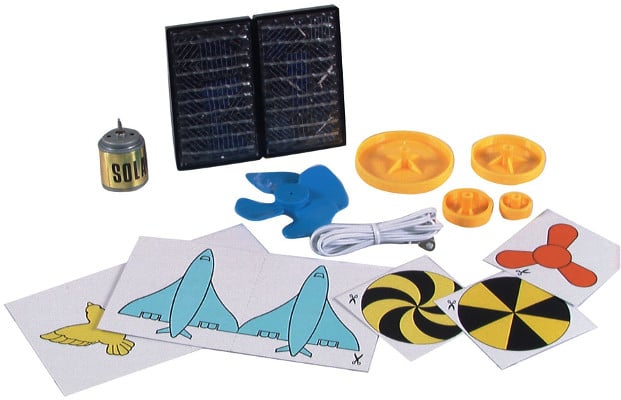
2. Solar Educational Kit
Product code: KI2010
This solar educational kit lets students build a solar-powered model. It comes with a solar module, motor, fan blade and instruction booklet.
3. Solar Grasshopper Kit Mini
No longer available
Product code: JGT3751
This Solar Grasshopper Kit Mini is a fun solar energy learning tool. When the sun glares on its solar-panelled back, it jumps around all over the place.
A brilliant demonstration of a solar panel that transforms renewable energy into electricity. What a great way to showcase and learn about environmentally friendly energy sources!
Recommended for ages 8+
4. 4 in 1 Solar Robot Kit
No longer available
Product code: JKJ8965
This ingenious kit can be assembled into four different models. You can make a T-Rex, Rhino beetle, robot, and a futuristic miners drilling machine.
These creations are powered by a solar panel that drives an electric motor and gears. This means you can build the kit with no batteries or tools apart from some diagonal cutters.
Even better, you can even customise your own robot with the included decals.
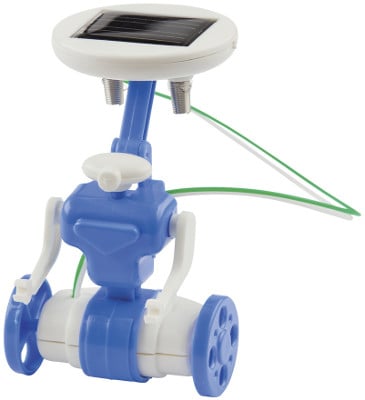
5. 6 in 1 Solar Robot Educational Kit
Product code: JKJ8936
This solar robot kit includes all the parts needed to construct up to six different projects. Choose between a robot, helicopter, plane, windmill, airboat or even a three-wheeler!
For the best results, use it in direct sunlight. For cloudy days use a 50W halogen light.
6. Solar Toy Kit 7 In 1 Space Fleet
No longer available
Product code: ATK1114
This amazing kit can be assembled into six different motorised toys. Plus, it comes with a solar-powered recharging station! The space fleet kit is a fantastic way to learn about solar energy and is great for kids, indeed.
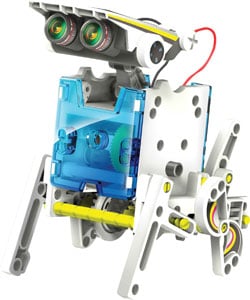
7. Solar Robotics Kit 14-in-1
Product code: JKJ8966
This fun kit allows you to transform it into 14 unique creations. Kids can choose from turtle bot, boat bot, dog bot and many more.
Challenge your kids to learn about solar power and electronics with this 14-in-1 solar kit!
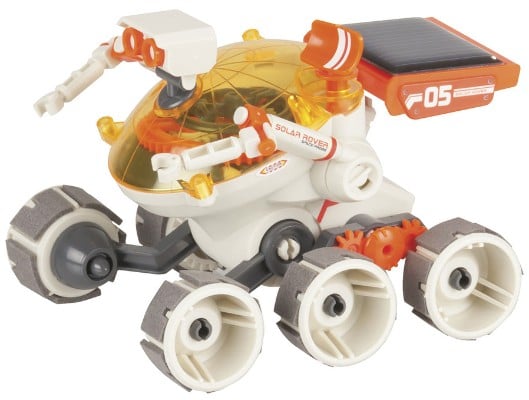
8. Solar Rover Kit
Product code: JKJ9026
Learn about construction, solar, gears and get inspired to reach for the stars! The Solar Rover sleeps at night, but he is out exploring during the day.
His radar dish scans the landscape as he prowls around on his six wheels. Great for kids interested in space!
Solar Educational Kits: The Bottom Line
Discussing the concept of solar energy with children can be challenging. Fortunately, we can educate them with the help of this guide and these beneficial toys.
Kids love to participate in fun activities. And solar education kits are exemplary in providing early learning on solar energy. They can get the kids interested in STEM fields, too. This includes Science, Technology, Engineering, and Mathematics.
There is nothing better than learning while having fun!
© Wiltronics Research Pty Ltd 2022
Write a Comment
You must be logged in to post a comment.